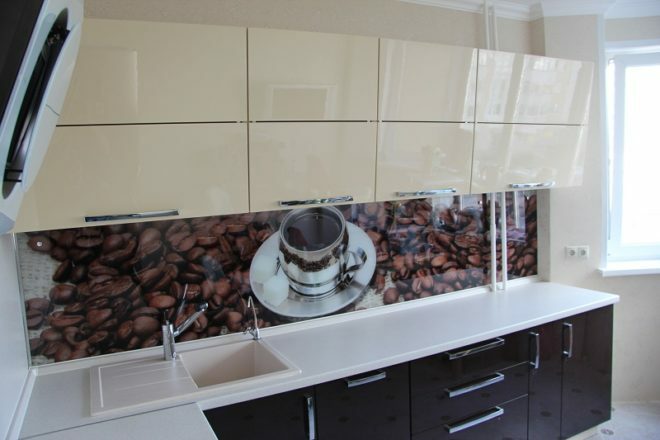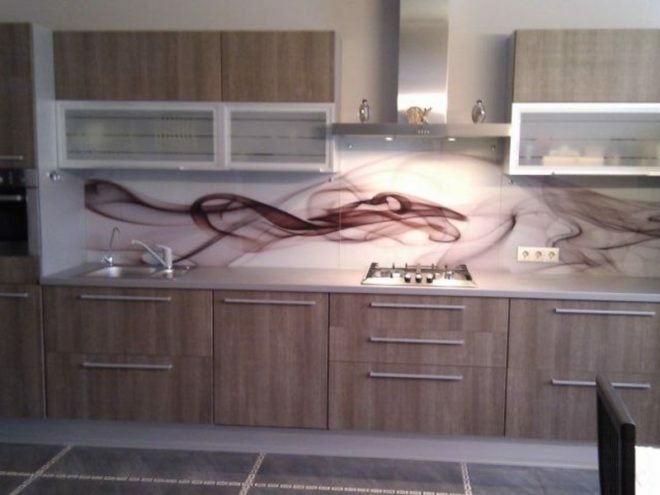A glass backsplash is a good alternative to using ceramic finishing tiles in the hob area and is an order of magnitude superior in quality characteristics to any wallpaper or decorative plaster in the kitchen. Let's consider what it is (photo examples) and what are the features of its installation and use.

Advantages
- One-piece coating. Since solid glass is used for manufacturing, there are no seams or joints on it, in which dirt would inevitably accumulate.
- Wear resistance. It is resistant to moisture and steam, does not absorb fat at all.
- Expanding space in small kitchens and increasing the amount of light due to the reflective properties of glass.
- Ease of cleansing.
- Ease of installation.
- Originality of design. Thanks to modern technology, there is an unlimited choice of colors and patterns that can complement any interior.
- Backlight. You can additionally install local lighting.

Attention! Earned on our website kitchen designer. You can familiarize yourself with it and design your dream kitchen for free! May also come in handy wardrobes designer.
Flaws
The disadvantages include the inability to make additional holes or adjust the dimensions of those already made.

Varieties
There are several types of such a decorative panel.
Clear glass
They are glossy or matte. Glossy is almost invisible in the kitchen, and its main task is to protect the surface from dirt, steam and oil stains. The apron made of frosted glass has a more interesting and unusual look.

Photo printing on glass (skinned)
This option is one of the most popular among buyers. In addition to its classic characteristics, it has an individual design that is resistant to external influences. Its durability is due to the fact that the image (drawing or even a family photo) is applied from the inside using a special technology. The picture is resistant to fading, moisture and can withstand temperatures up to 120 degrees. 3D-printed aprons look especially catchy and original, they become a real center of attention of the kitchen and attract the eyes of guests.

Plain colored glass
Tinted or transparent glass looks laconic and stylish, in addition, the color can be matched to any kitchen interior. Colored glasses must undergo heat treatment, and paint is applied to the back surface, which ensures the design resistance to dirt and ease of cleaning.

Image on vinyl
This type is a more budgetary alternative to photo printing. Printed vinyl is applied behind the glass that protects the image being used. However, the film can wrinkle under glass, fade and peel off - this is especially true if the work or materials used were of inadequate quality.

Tempered glass (triplex)
Triplex is a special tempered glass for the kitchen. Its main advantage is the maximum protection of the image from external influences. Such an apron is made as follows: an image is placed between two layers and "hardened". This structure simply cannot be broken into fragments - in the case of a sufficiently powerful blow (which happens extremely rarely in operation) it will be covered with a cobweb of cracks, but in no case will it crumble to smithereens. However, they are less popular due to their high cost and some difficulties in mounting holes.

Mirror apron
Looks somewhat unusual, visually increases the illumination and free space. However, many people do not quite like watching their reflection while cooking or cleaning. For this reason, they are most often made not completely mirrored, but with matte and decorative elements.

Features of installing a glass panel
Usually, the installation of such an apron takes very little time - skilled workers will need no more than 2 hours. It is fixed on the wall in different ways.
Using fasteners during installation
This method is common and the most optimal, since the fasteners securely fix even a very thick and weighty apron. An additional advantage is the absence of preparatory work for leveling the wall surface. It can also be easily removed and then replaced.

Types of fasteners:
- A hinged mount is a small metal plate that is inserted into the glass. For installation, no holes are made on the apron, and the hooks themselves are hardly noticeable. This method helps to most accurately and evenly place it relative to the wall and furniture.
- Pass-through mount. For this type of fastener, holes are made in the glass of the apron (before it is "hardened"), and after installation, they are closed with decorative plugs. The advantage of this type of fastening is that during installation there is usually a gap of 4-5 mm between it. and a wall, which allows you to mount such panels on very curved surfaces or even on an old tiled tiles.
- Using liquid nails or glue. In this case, the apron is glued directly to the wall. It is important enough in this method that the surface is pre-prepared for work: leveled, plastered and completely dried. Installing it with an adhesive base is much easier (there is no need to drill a wall, use fasteners), and on the other hand, this installation method is considered less reliable.
- If desired, installation by one of the above methods can be done on your own, however, this requires a certain skill and the presence of skills in working with glass.

Caring for your kitchen glass backsplash
You should pay attention to the following points, especially if you have a white apron for white kitchen from glass:
- Rapid reaction. It is easiest to remove dirt immediately after it occurs; for this it is worth using a universal microfiber cloth;
- Soft attitude. To care for glass, you should definitely opt for soft napkins and washcloths, which will avoid scuffs and scratches on the glossy surface;
- A selection of cleaning agents with dirt-repellent properties and special liquids to keep the glass surface shiny.
What your decorative kitchen can be (example photos)

In coffee tones

In marine tones

White patterns on glass

Colored glass apron

Megapolis in the kitchen

Yellow flowers


Execution in dark colors

Transparent glass apron

Patterns on glass
Do you know what a kitchen apron is?
Kitchen cabinet facades
9.78%
Apron hanging on a hook next to the sink
15.11%
Wall between the bottom edge of the wall cabinets and the worktop
75.11%
Voted: 225
average rating 0 / 5. Number of ratings: 0
No ratings yet. Be the first to rate.


